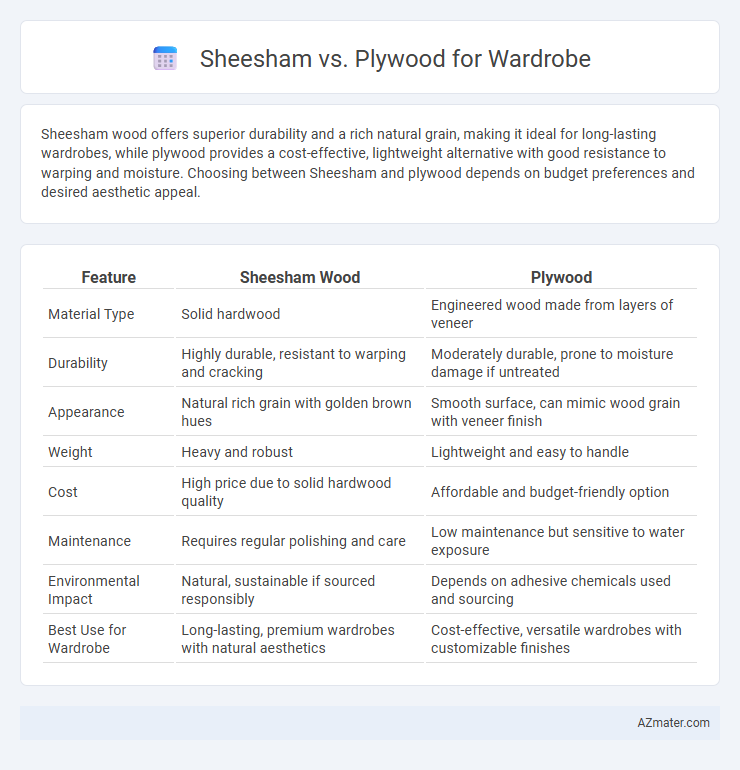Sheesham wood offers superior durability and a rich natural grain, making it ideal for long-lasting wardrobes, while plywood provides a cost-effective, lightweight alternative with good resistance to warping and moisture. Choosing between Sheesham and plywood depends on budget preferences and desired aesthetic appeal.
Table of Comparison
| Feature | Sheesham Wood | Plywood |
|---|---|---|
| Material Type | Solid hardwood | Engineered wood made from layers of veneer |
| Durability | Highly durable, resistant to warping and cracking | Moderately durable, prone to moisture damage if untreated |
| Appearance | Natural rich grain with golden brown hues | Smooth surface, can mimic wood grain with veneer finish |
| Weight | Heavy and robust | Lightweight and easy to handle |
| Cost | High price due to solid hardwood quality | Affordable and budget-friendly option |
| Maintenance | Requires regular polishing and care | Low maintenance but sensitive to water exposure |
| Environmental Impact | Natural, sustainable if sourced responsibly | Depends on adhesive chemicals used and sourcing |
| Best Use for Wardrobe | Long-lasting, premium wardrobes with natural aesthetics | Cost-effective, versatile wardrobes with customizable finishes |
Introduction to Sheesham and Plywood Wardrobes
Sheesham wardrobes, crafted from the durable and richly-grained Sheesham wood, offer natural resistance to decay and a luxurious, warm finish that enhances bedroom aesthetics. Plywood wardrobes are made from multiple thin layers of wood veneer glued together, providing stability, resistance to warping, and cost-effectiveness while allowing various finishes for customizable looks. Both materials serve as popular choices for wardrobes, with Sheesham prized for its natural beauty and longevity, and plywood favored for its affordability and versatility.
Material Composition: Sheesham vs Plywood
Sheesham wood, derived from Dalbergia sissoo, is a dense hardwood known for its natural durability, rich grain patterns, and resistance to pests, making it a premium choice for wardrobes. Plywood consists of multiple layers of thin wood veneers glued together, offering stability, resistance to warping, and cost-effectiveness but lacks the solid wood's natural texture and strength. Choosing between Sheesham and plywood depends on desired wardrobe longevity, aesthetic appeal, and budget, with Sheesham excelling in natural beauty and plywood in versatility and affordability.
Durability and Strength Comparison
Sheesham wood, known for its dense grain and natural oils, offers superior durability and resistance to wear, making it ideal for long-lasting wardrobes. Plywood, crafted from multiple wood layers glued together, provides consistent strength and less susceptibility to warping or cracking under humidity. While Sheesham excels in natural robustness and aesthetic appeal, plywood ensures structural stability and cost-effective durability for wardrobe construction.
Aesthetic Appeal and Finishes
Sheesham wood offers a rich, natural grain with deep hues that enhance a wardrobe's aesthetic appeal, providing a luxurious and timeless finish. Plywood, while versatile and available in various veneers, often lacks the unique texture and warmth of solid Sheesham but allows for smooth, uniform finishes that can be customized with laminates and paints. The choice between Sheesham and plywood depends on the desired balance between natural beauty and design flexibility in wardrobe finishes.
Cost Factor: Price Differences Analyzed
Sheesham wood wardrobes typically cost more due to the hardwood's durability, natural grain patterns, and resistance to termites compared to plywood, which is a manufactured product made from layers of wood veneer bonded with adhesive. Plywood wardrobes offer a budget-friendly alternative with moderate strength and weight, but may require frequent maintenance and are less resistant to moisture and termites. Price differences also reflect long-term value, where Sheesham wardrobes have higher upfront costs but greater longevity and aesthetic appeal, whereas plywood options are ideal for cost-conscious buyers prioritizing initial affordability.
Maintenance and Longevity
Sheesham wood wardrobes offer superior durability and natural resistance to pests and moisture, resulting in lower maintenance compared to plywood. Plywood wardrobes, while cost-effective, are more prone to delamination and water damage, requiring regular sealing and careful handling. Sheesham's dense grain structure enhances longevity, making it a preferred choice for wardrobes that endure years of use with minimal upkeep.
Eco-Friendliness and Sustainability
Sheesham wood, a durable and naturally pest-resistant hardwood, offers superior eco-friendliness due to its renewable sourcing and long lifespan, minimizing the need for frequent replacements. Plywood, while versatile and cost-effective, often involves the use of adhesives containing formaldehyde, which raises concerns about indoor air quality and environmental impact. Choosing Sheesham for wardrobes supports sustainable forestry practices and reduces chemical exposure, making it a greener option compared to conventional plywood products.
Customization and Design Flexibility
Sheesham wood offers superior customization and design flexibility for wardrobes due to its natural grain patterns and solid durability, allowing intricate carvings and bespoke finishes. Plywood provides versatility with its lightweight structure and ease of cutting, making it suitable for modular and contemporary wardrobe designs. Custom wardrobes in Sheesham tend to be more robust and detailed, while plywood enables a broader range of shapes and quick assembly options.
Suitability for Different Climate Conditions
Sheesham wood offers natural resistance to moisture and termites, making it highly suitable for humid and tropical climates where durability against dampness is essential. Plywood, especially marine-grade variants, provides excellent stability in fluctuating temperatures and humidity, preventing warping and swelling in variable climates. Choosing Sheesham is ideal for warm, moist environments, while plywood excels in regions with extreme temperature changes or high humidity levels.
Verdict: Which is Best for Your Wardrobe?
Sheesham wood offers superior durability, natural resistance to pests, and a rich, attractive grain, making it ideal for long-lasting and aesthetically pleasing wardrobes. Plywood provides a cost-effective, stable alternative resistant to warping and is available in various finishes, but it lacks the natural beauty and strength of solid wood. Choosing between Sheesham and plywood depends on budget priorities, desired longevity, and the importance of authentic wood appearance for your wardrobe.

Infographic: Sheesham vs Plywood for Wardrobe
 azmater.com
azmater.com